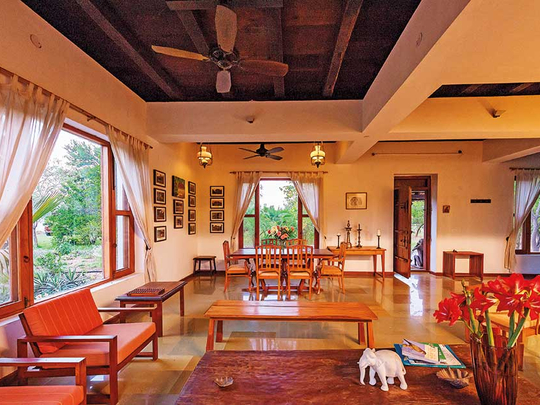
Mepral, Kerala: When George Oommen was 16 years old, he inherited a two-storey house on a river in Mepral, a village in the verdant southern Indian state of Kerala, where his father had grown up.
By tradition, the house was always passed to the youngest son, which he was. But it wasn’t a house he needed or wanted. He was a teenager, living with his family in Delhi.
After college, he moved to the United States to study at Harvard, where he worked for three decades as an architect. Ten years ago, he became a full-time abstract painter.
But the house meant something to him and his family. More than four generations had used the 300-year-old structure, built high above rice paddies in the river’s flood plain. But as family members went abroad or died, the house, named Meda, sat empty and went into decline.
Its foundation and lower floor were made of porous whitewashed laterite stone blocks that during monsoon floods sank a little farther into the soft ground; perched upstairs, the ancient structure of Anjili hardwood was joined, as in Japanese temples, without any nails.
Its peaked roof made of clay tiles from Mangalore effectively kept out storms. Over the years, Meda’s three rooms and two wide verandas on the north and south sides sheltered the family members, who grew rice.
“I still had an emotional connection to this building and was thinking of renovating it,” Oommen said. “But, even if I had raised it again, the land was unstable and no one in our extended family was willing to return to that remote location.”
Decision to sell
Oommen, 75, still travels to India, which inspires his painting, but he does not go to the house. Rather, he goes to an island called Mankotta that still has the unspoilt air of the time when he lived in Kerala as a boy amid landscapes devoid of modern roads and malls.
About seven years ago, Oommen decided he had to sell the house because his children did not want it. But potential buyers were interested only in the land, so they would have dismantled and sold Meda as well-seasoned timber and artefacts for tourists.
Pradeep Sachdeva, a landscape architect, in the home he had transported to his land in Gurugram. The ancient wood was joined without nails, helping it survive the disassembly. |
New York Times News Service |
He did not want that to happen. Fortunately, a friend, Pradeep Sachdeva, 59, heard about his predicament and agreed to buy the 185 square-metre house and move it piece by piece to his own 1.4-hectare farm in Sadhrana village, south of Delhi, where he lives.
Sachdeva, an architect, saw a future for Meda as a guesthouse at his weekend house. He is known in India for his interiors at resorts like the Samode Palace in Rajasthan, and in Delhi for the large urban renewal projects such as the Dilli Haat market and the 8-hectare Garden of Five Senses.
Oommen was overjoyed. “I never thought of taking it apart and putting it in another location,” he said.
But villagers who rarely ventured 160 kilometres outside Mepral did not want to see it go 2,400 kilometres away.
“In that secluded area, which is largely below sea level, people historically went to Meda seeking refuge during floods,” Oommen said. But it was either move it or destroy it. “Their important icon would have been entirely lost if we had not moved it,” he said. “I feel I saved a piece of my family.”
For the move in late 2010, a speaker of Malayalam (Kerala’s main language) on the staff of Sachdeva’s firm recruited Narayan Achari, one of the last Mepral carpenters skilled in building traditional Kerala wood houses. Together with a small team, they dismantled, numbered and documented Meda’s individual components. As a last nod to tradition, before the parts were loaded onto northbound trucks, they sought blessings at the local temple for safe passage.
Reassembled in six weeks
In the spring of 2011, Achari and his assistants put the house back together at Sachdeva’s farm on a new ground floor with walls of plastered brick.
“The joinery was so simple and sophisticated that within six weeks Meda was reassembled,” Sachdeva said. “It looked better than ever and good for another hundred years.”
A modern bathroom and kitchen are both cordoned off by partition walls from the otherwise open-plan ground floor.
“I really wanted a columnless space for this adaptive reuse of the building as a functioning, contemporary home,” Sachdeva said. “If I did not make it usable, it would gather cobwebs. Now, friends come and stay, and occasionally I use it, too.”
He also turned to some of his friends to help re-imagine the house. The British designer John Bowman, who lives and works in Rajokri — between New Delhi (one of Delhi’s districts) and Gurgaon — created a cast-iron spiral staircase and brass railing leading to the top floor. It replaced a dilapidated exterior wood staircase whose treads were repurposed as a dining table and shelving.
In a bathroom added upstairs, Bowman fashioned a dull-brass sink etched with a leaf pattern and a cast-brass circular shower pan, echoing the building’s handmade aesthetic and natural surroundings.
Upstairs, “we tried to conserve nearly everything as it was, although we did add electricity and plumbing,” Sachdeva said. Ventilation openings in the gable ends of the building and a few roof tiles are also new.
The guesthouse, oriented north-south as it always was, is in a garden now. “It seems to belong there, even though the environment is completely different culturally and climatically,” said Sachdeva, who is also a landscape architect and a co-author of A Naturalist’s Guide to Trees & Shrubs of India.
— New York Times News Service










